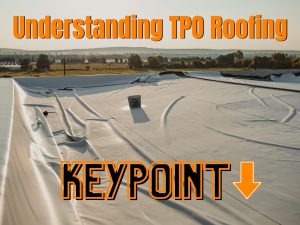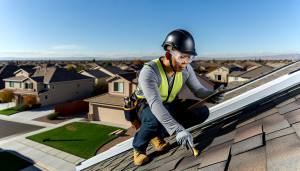In the ever-evolving world of roofing, TPO (Thermoplastic Polyolefin) has emerged as a popular choice for its cost-effectiveness, energy efficiency, and ease of installation. As this innovative roofing option gains traction, it’s crucial to understand what is TPO roofing and how it compares to other materials. Buckle up and dive into the world of TPO roofing to make an informed decision for your next roofing project.
Table of Contents
ToggleKey Takeaways
- TPO roofing is a single-ply membrane made of polypropylene and ethylene-propylene rubber, providing durability, UV ray reflection, watertight seal and energy efficiency.
- Cost factors for TPO roofing include material thickness, labor expenses & complexity. Estimated cost per sq ft ranges from $5.50 to $8.75 with an average cost of $10700 for 1500sqft roofs.
- Regular maintenance inspections are essential to ensure optimal performance & extended lifespan. When selecting contractors prioritize experienced/certified ones with references & online reviews
Understanding TPO Roofing

Composed of synthetics and reinforced scrim, TPO roofing is a single-ply roofing membrane typically used for covering flat roofs. The TPO roofing system consists of the following layers:
- TPO roofing membrane (base layer)
- Anti-oxidation membrane (PETE or glass fiber)
- Fireproof layer
- Non-woven fabric layer (for added protection)
With a market share of 40% in the commercial roofing systems industry and 20 years of use, TPO roofing has proven itself as a reliable and cost-effective choice for various applications.
Made from a blend of polypropylene and ethylene propylene rubber, TPO roofing is an innovative roofing material that boasts:
- Durability
- Resistance to various environmental stressors
- Flexibility
- Resistance to corrosion, mildew, and algae
Flat roofs are commonly used for low-slope roofs on commercial and industrial buildings, as well as residential flat roofs.
Key Features of TPO Roofing
One of the primary reasons behind the rising popularity of TPO roofing is its unique set of features. A TPO membrane roof is a single-ply membrane made of polypropylene and ethylene-propylene rubber, which imparts flexibility, durability, and resistance to various environmental factors. TPO roofing membranes are available in thicknesses ranging from 45 mils (1.1 mm) to 60 mils (1.5 mm), catering to the varying needs of different projects. The membrane rolls come in widths of 6, 8, 10, and 12 feet, adding to the ease of installation and customization.
TPO roofing offers several benefits:
- It reflects the sun’s ultraviolet (UV) rays, reducing heat absorption and improving energy efficiency.
- It provides a water-tight seal, protecting the building from leaks and water damage.
- When properly installed and maintained, a commercial single-ply membrane roof can last up to 30 years, making it a wise investment for both commercial and residential buildings.
Common Applications of TPO Roofing
TPO roofing is widely used in commercial and industrial buildings due to its many benefits and suitability for flat or low-slope roofs. Its resistance to corrosion, mildew, and algae, along with its ability to withstand movement and settling, make it an ideal choice for various roofing applications.
Residential flat roofs can also benefit from TPO roofing, as it offers the same advantages as in commercial applications. With its energy-efficient properties and compatibility with a range of building types, TPO roofing continues to gain popularity as a top choice for both commercial and residential projects.
Comparing TPO Roofing with Other Roofing Materials

A comparison of TPO roofing with other popular roofing materials like PVC and EPDM reveals the following:
- PVC, or Polyvinyl Chloride, is another single-ply membrane known for its excellent weatherability and flame-retardant properties.
- EPDM roofing is generally darker in color and is fastened to the roof decking with fasteners.
- TPO roofing can be attached through mechanical fasteners or adhesive systems.
TPO roofing offers several advantages over other roofing materials, such as enhanced UV resistance, chemical exposure resistance, and better flexibility, making it simpler to install. However, TPO roofing is relatively new compared to other materials, and some products have experienced premature aging and seam failures due to prolonged exposure to hot air and intense heat.
Despite these potential drawbacks, TPO roofing remains a cost-effective and energy-efficient choice for many roofing applications.
Advantages of TPO Roofing
TPO roofing is one of the most cost-effective flat roofing materials available, with a price point lower than that of EPDM or other types of rolled rubber roofing. Its energy efficiency is another significant advantage, as TPO roofing’s cool roof properties help reduce energy consumption and improve indoor comfort during the summer months.
Apart from its cost and energy efficiency, TPO roofing also offers other benefits like resistance to mold and dirt, flexibility, and durability. These advantages make TPO roofing a popular choice among building owners and property managers seeking a long-lasting and environmentally friendly roofing option.
Disadvantages of TPO Roofing
Despite its many advantages, TPO roofing has some potential drawbacks. To make an informed decision, it’s essential to consider the pros and cons of TPO roofs. These include:
- Cases of TPO roofs failing prematurely or facing issues like seam failures due to prolonged heat exposure
- TPO roofing is more costly than other materials
- TPO roofing can be more challenging to repair
However, advancements in TPO roofing technology continue to address these concerns, with manufacturers working to improve durability and longevity. As the roofing industry evolves, TPO roofing is expected to become even more reliable and cost-effective, making it an attractive option for building owners and property managers.
TPO Roofing Installation Process

The TPO roofing installation process involves several steps to ensure a watertight and energy-efficient roof. From surface preparation to attaching the TPO membrane and seaming and finishing the roof, every step is crucial to the overall performance and longevity of the TPO roofing system.
A grasp of the TPO roofing installation process, including the specifics of TPO roof installation, can guide building owners and property managers in their decisions when selecting a roofing contractor, ensuring the selected contractor adheres to industry standards for a successful installation.
Preparing the Roof Surface
A successful TPO roofing installation requires proper cleaning and preparation of the roof substrate. This involves scraping any existing roofing material, eliminating debris, and cleaning the surface with a pressure washer. The deck surface should also be inspected for any signs of damage, such as rot, cracks, or holes, and verified that the surface is level and clear of debris.
The existing roof surface must also be free of blisters or damaged areas, which can be removed using a utility knife or a circular saw. Insulation foam should be installed and cut to fit the roof surface, and secured with an adhesive.
Proper surface preparation is crucial to ensure a smooth and level surface for the TPO membrane to adhere to, ultimately resulting in a long-lasting and efficient roofing system.
Attaching the TPO Membrane
After preparing the roof surface, you can attach the TPO membrane using either mechanical fasteners or adhesive systems, depending on the building’s requirements and the selected TPO system. The installation process involves unrolling the TPO membrane, cutting it to size, and affixing it with fasteners or adhesives.
Regardless of the attachment method, it is essential to ensure that the TPO membrane is securely fastened to the roof deck to prevent wind uplift and other potential issues. Proper attachment of the TPO membrane contributes to the overall durability and performance of the roofing system.
Seaming and Finishing the TPO Roof
After attaching the TPO membrane, the seams must be heat-welded to ensure a watertight seal. This process involves using a heat gun and seam welding machine to fuse the seams together, forming a unified and waterproof roofing system. Hand crimpers are employed to form the seams around clips and end laps.
Finishing touches, such as installing flashings and edge details, complete the TPO roofing installation process. A final inspection should be conducted to identify any potential issues or improper installation.
By following the proper TPO roofing installation process and adhering to industry standards, building owners and property managers can ensure a long-lasting and efficient TPO roofing system.
TPO Roofing Costs and Considerations
To estimate the cost of a TPO roofing project, various factors such as material thickness, labor expenses, and roof complexity must be considered. Understanding these factors can help building owners and property managers make informed decisions when selecting a TPO roofing system and contractor.
By analyzing the factors that influence TPO roofing costs and estimating the cost per square foot, building owners and property managers can better evaluate their options and make cost-effective decisions regarding their roofing projects.
Cost Factors for TPO Roofing
The cost of TPO roofing is determined by factors such as material thickness, labor, and the complexity of the roof. The thickness of the TPO membrane employed in the roofing system affects the cost, as thicker membranes are more expensive.
Labor costs typically range from $3 to $7 per square foot for installation. The complexity of the roof, determined by its size and shape, as well as any additional features that need to be considered during installation, also impacts the overall cost of a TPO roofing project.
By understanding these cost factors, building owners and property managers can better estimate the overall expenses associated with their TPO roofing projects.
Estimating TPO Roofing Costs per Square Foot
A guide to estimating TPO roofing costs can be provided based on material and labor expenses. The roofing cost for TPO typically ranges from $5.50 to $8.75 per square foot, with an average cost of $10,700 for a 1,500-square-foot roof.
By considering the cost of TPO roofing materials and labor, building owners and property managers can effectively estimate the expense of their TPO roofing projects. This information can be invaluable in making informed decisions and selecting the best TPO roofing option for their specific needs.
Maintaining and Repairing Your TPO Roof
To prolong the lifespan of a TPO roof and ensure its energy efficiency and durability, understanding the benefits of TPO is crucial. Regular maintenance, such as routine inspections and cleaning, can help to identify and address any potential issues before they become more severe.
Understanding common TPO roof issues and how to address them can help building owners and property managers ensure the longevity and performance of their TPO roofing systems, ultimately saving time and money in the long run.
Regular Maintenance Tips
Regular maintenance is vital for keeping a TPO roof in optimal condition. Performing inspections at least annually helps to detect any signs of damage or wear and tear, while regular cleaning removes dirt, debris, or other contaminants that may have accumulated on the roof.
By following these maintenance tips, building owners and property managers can maintain the energy efficiency and durability of their TPO roofs, potentially extending their lifespan to the upper end of the 20-30 year range and beyond.
Identifying and Addressing Common TPO Roof Issues
Recognizing signs of potential problems with a TPO roof is crucial for timely intervention and repair. Issues such as seam failures, water leaks, or surface punctures can lead to more severe problems if left unaddressed.
Taking appropriate action to repair these issues, such as patching punctures or re-welding seams, can help maintain the performance and longevity of a TPO roof. By staying vigilant and addressing common TPO roof issues, building owners and property managers can ensure the continued efficiency and durability of their roofing system.
Hiring a Professional TPO Roofing Contractor
Although some building owners or property managers might contemplate handling TPO roofing installation themselves, it’s often more prudent to hire a professional roofing contractor. Contractors have the necessary experience, specialized tools, and access to TPO roofing materials at competitive prices.
By evaluating contractor experience and asking the right questions, building owners and property managers can ensure a successful TPO roofing installation that adheres to industry standards and provides long-lasting protection for their buildings.
Evaluating Contractor Experience
In the selection of a TPO roofing contractor, prioritizing those with a proven track record and TPO roofing installation certifications, such as those from the Roofing Industry Educational Institute (RIEI) or the National Roofing Contractors Association (NRCA), is vital. Requesting references from past TPO roofing projects and reviewing online reviews can also provide valuable insights into the contractor’s experience and work quality.
By examining a contractor’s experience and qualifications, building owners and property managers can have confidence in their decision, ensuring a successful TPO roofing installation.
Questions to Ask Your TPO Roofing Contractor
- Question: How long have you been installing TPO roofing? Answer: The contractor should be able to provide details regarding the duration of their experience with TPO roofing.
- Question: Can you provide proof of licensing and insurance? Answer: The contractor should be able to provide documentation to verify their licensing and insurance status.
- Question: Can you provide references from previous TPO roofing projects? Answer: The contractor should be able to furnish references from prior TPO roofing projects.
- Question: What is the warranty coverage for the TPO roofing material and installation? Answer: The contractor should be able to provide you with the relevant warranty information for the TPO roofing material and installation.
- Question: What is the anticipated timeline for the TPO roofing installation? Answer: The contractor should be able to furnish details on the anticipated timeline for the TPO roofing installation.
By asking these questions and evaluating the contractor’s experience, building owners and property managers can make informed decisions and ensure a successful TPO roofing installation.
Summary
In conclusion, TPO roofing offers numerous benefits, such as cost-effectiveness, energy efficiency, and ease of installation, making it an attractive option for both commercial and residential applications. Understanding the TPO roofing installation process, maintenance requirements, and potential issues can help building owners and property managers make informed decisions and ensure the longevity and performance of their TPO roofs. With a growing market share and continuous improvements in technology, it’s clear that TPO roofing is here to stay as a top choice for roofing solutions.
Frequently Asked Questions
How long will a TPO roof last?
A TPO roof, when properly maintained, can last up to 20-30 years.
Is a TPO roof a good roof?
TPO roofs are an environmentally-friendly choice with excellent reflectivity, making them a great roofing option.
Which is better TPO or EPDM roofing?
TPO roofs offer superior durability and seam strength compared to EPDM, making it a better long-term roofing solution.
Is it OK to walk on a TPO roof?
Although TPO is resistant to tears, impacts and punctures and provides flexibility to the underlying structure, it is recommended to install walk pads to reduce wear and tear while walking on the roof.
What is tpo roof?
TPO (thermoplastic polyolefin) roofing is a single-ply white membrane ideal for flat or low-slope roofs. This material reflects heat instead of absorbing it, making it an excellent choice for keeping the interior temperature cool.


